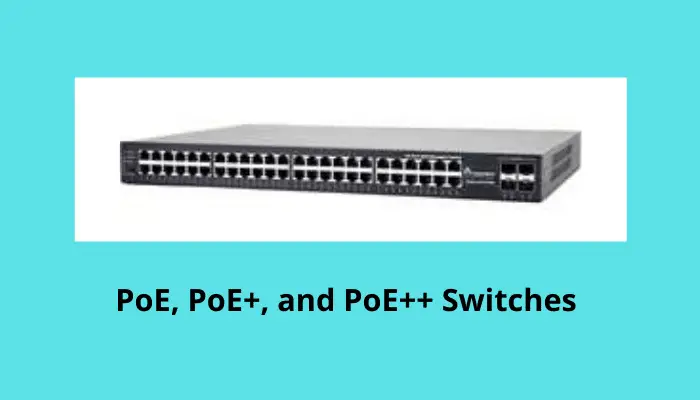Power over Ethernet or PoE technology finds uses in almost all industrial segments pertaining to business networks. This is because the technology enables data and power transmission over a single cable through separate lines. PoE is mainly designed for wired Ethernet as well as fiber optic networks. As far as fiber optic networks are concerned, you can connect a PoE switch and use a media converter along with it for transmission signal conversion. PoE is gaining momentum owing to the simplicity and efficiency it assures, and saves on external electric supplies for powering devices. Like other technologies, POE is administered through several PoE devices, such as PoE switches. There are different versions of Power over Ethernet switches in use today – PoE switches, PoE+ switches, and PoE++ switches. Would you like to know more about these switches? If that sounds yes, then this post answers everything about these devices. So, stay tuned.
A Quick Overview of PoE, PoE+, and PoE++ Switches
Before getting into their differentiating factors, it is important to know about each of these switches. After the initial development and implementation of PoE switches, which are still in use, PoE+ and PoE++ were developed as better versions of the former.
- PoE: A PoE switch has in-built Power over Ethernet functionality. These types of switches supply power to network devices using Ethernet cables, like Cat6 cable. If there are distributed switches in your network, it is possible to get PoE pass-through switches. These switches can also pass power to end devices such as phones, cameras, and so on. Most of the 802.3af switches can deliver 15.4 watts over an Ethernet cable with a voltage ranging from 44v to 57v.
- PoE+: As the name suggests, it is an advanced version of PoE technology developed and published in 2009 by the Institute of Electrical and Electronics Engineers (IEEE 802.3at standard). In many cases, power devices within the network require more PoE wattage up to 12.95, and, PoE+ is the best solution that supports a higher power consumption requirement. Like a PoE network switch, PoE+ supplies power over two pairs. But, it has an additional power class that can deliver power watts up to 25.5 with a voltage range varying from 42.5v to 57v. A PoE+ network switch can supply maximum power of 30W with a voltage range from 50v to 77v.
- PoE++: PoE++ network switch is the next generation of PoE+ technology. It is designed to provide power to broader device applications. It is classified into two different types – PoE++ type 3 and PoE++ type 4. Type 3 powered switches can hit 51 watts with a voltage range from 42.5v to 57v. Type 4 switches enable four twisted pairs in a copper cable to deliver power up to 71 watts. Being an upgraded version of the PoE network switch and PoE+ switch, PoE++ can hit 60 watts on each port under PoE++ type 3 and up to 100 watts under the PoE++ type 4.
PoE vs PoE+ vs PoE++ – Know the Real Difference
The following are some important pointers that will help you understand the difference between these switches.
- One of the major differences between PoE, PoE+, and PoE++ switches is the IEEE standards. A PoE switch is designed as per 802.3af, PoE+ as per 802.3at, and PoE++ as per 802.3bt.
- Next, Ethernet cabling is an important consideration when differentiating these switches. PoE switch use two pair twisted cables, and the same goes for the PoE+ network switch. On the other hand, PoE++ uses four pairs of twisted cables.
- Differences among these switches lie in the maximum power supply delivered by each port and their working mode, which reflect on their applications. PoE switches are designed to support network devices that require a power supply of up to 15.4watts. The list includes sensors, meters, wireless access points, surveillance systems, and many more. PoE+ switches support devices such as video IP phones, wireless access points with multiple antennas, and complex surveillance cameras. PoE++ switches can support devices that need higher power wattage such as video conferencing system components and building management devices, laptops, televisions, and so on.
After understanding PoE switches and their increasing use in several industrial applications, it is essential to source them from the authorized and certified manufacturers and suppliers. VERSITRON is one of the leading and trustworthy manufacturers and providers of industrial PoE switches. Over the years, the company has been offering PoE switches in different configurations. These switches support Ethernet, Fast Ethernet, and Gigabit Ethernet applications for secure and enhanced communication links. The company also offers several other network devices for fiber optic as well as blended networks.







